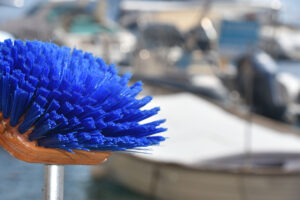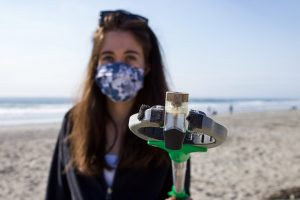BEN FRANKLIN ONCE SAID, “In this world, nothing is certain except death and taxes.” Ben was not a boat owner. We know the more accurate saying should be, “…nothing is certain except death, taxes and boat maintenance.” Caring for your boat requires effort, but it can maximize your time on the water and help the environment.
BEAUTY IS MORE THAN SKIN DEEP
Proper care of your boat’s exterior is not just about aesthetics. If you boat in saltwater, a freshwater rinse after use can reduce salt corrosion on surfaces. How often you need to wash your boat with a cleaning agent depends on how and where you boat. On average cleaning is recommended every two weeks, more often if you see dirt or salt build up.

Whether rinsing or washing, be mindful of your runoff. Treated water, detergents and debris can easily find their way to a marine ecosystem. Choose your location and cleaning agents accordingly. Environmentally friendly versions of boat soaps are available and prove to be effective.
Waxing is essential to the integrity of most boat finishes. Recommended every three to four months, waxing protects against salt water, algae and sun damage. Regular waxing slows the buildup of grime on surfaces, making cleaning easier and reducing the need for harmful chemicals.
Do not overlook below the waterline. Unwanted barnacles, sponges and algae growth will influence boat performance and efficiency. Bottom paints are the standard for inhibiting these growths. Generally, you should apply paint once a year or at least have it checked to determine the need. Eco-friendly alternative hull paints are available. An Environmental Protection Agency supported study concluded that these alternative paints work well and last longer than traditional copper-based paints.
Regular hull cleaning is also important. On average, cleanings are done every few months depending on the speed of new growth and boat use. Ideally, you want to address hull growth when it is easy to remove. If divers need to use abrasive tools for scrubbing, bottom paint may be removed, releasing harmful particulates into the ecosystem.
SHIPSHAPE ON AND AROUND YOUR BOAT
The nautical origin of the term “shipshape,” meaning tidy, is a testament to the need for orderliness on a boat. Boats can be busy places where gear and people intersect. When maintaining a boat’s interior, start with keeping items properly stowed. Well-secured boat gear or trash is not just a safety issue. Items accidentally tossed or blown overboard become hazards for wildlife.
Interior maintenance is a bit like general housekeeping, with one significant difference: greywater. Water from sinks, showers or appliances is directly pumped into the environment. Choosing cleaning agents with less toxic chemicals can help protect the ecosystem below your boat. Eco-friendly products exist for everyday cleaning and for battling mold and mildew. DIY cleaning concoctions utilizing fewer toxic ingredients, such as vinegar, baking soda or citrus oils, are another way to maintain your boat’s interior while protecting marine life.
CLEAN, CAREFUL CONTAINMENT
When it comes to boat maintenance, some aspects are less forgiving if neglected. Fueling, oil changes and bilge cleaning are vital to optimal cruising and protecting the environment. Eco-responsible boating means avoiding fuel spills. Fill tanks slowly, use absorbent pads to catch drips and spills, and never leave your fueling process unattended. Using soap to disperse a spill increases the environmental harm, and it is illegal.

A healthy flow of oil in the engine is a priority, but any flow of oil into the environment is destructive. Spill proofing your oil change process can protect the environment. Most boat manufacturers recommend oil changes every 100 hours or once a year, whichever happens first. Using a marine oil change pump allows you to pull the oil out of the engine and collect it in a reservoir in the change pump. Wrap a plastic bag or absorbent pad around filters to keep spills from the bilge.
Proper bilge maintenance is good for your boat as well as the environment. The bilge area collects wastewater or fluids from your engine, condensation drips from inside the hull, and water leaks from sinks or toilets. A clean bilge makes it easy to notice small leaks or accumulations before they become bigger issues. Because a bilge pump will discharge errant fluids directly overboard, keeping the bilge clear of oils or chemicals is environmentally helpful.
Regular attention to boat maintenance not only ensures better days on the water, but it can help protect our oceans and waterways. Whether it’s daily washings, monthly projects or seasonal tasks, we can all reap the benefits of eco-friendly boat upkeep. Ben Franklin may not have been a boat owner, but he certainly knew the wisdom of tending to one: “Beware of little expenses, a small leak will sink a big ship.”





